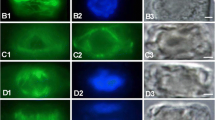Abstract.
The organization of the microtubule (MT) and actin microfilament (MF) cytoskeleton of tip-growing rhizoids and protonemata of characean green algae was examined by confocal laser scanning microscopy. This analysis included microinjection of fluorescent tubulin and phallotoxins into living cells, as well as immunofluorescence labeling of fixed material and fluorescent phallotoxin labeling of unfixed material. Although the morphologically very similar positively gravitropic (downward growing) rhizoids and negatively gravitropic (upward growing) protonemata show opposite gravitropic responses, no differences were detected in the extensive three-dimensional distribution of actin MFs and MTs in both cell types. Tubulin microinjection revealed that in contrast to internodal cells, fluorescent tubulin incorporated very slowly into the MT arrays of rhizoids, suggesting that MT dynamics are very different in tip-growing and diffusely expanding cells. Microtubules assembled from multiple sites at the plasma membrane in the basal zone, and a dense subapical array emerged from a diffuse nucleation centre on the basal side of the nuclear envelope. Immunofluorescence confirmed these distribution patterns but revealed more extensive MT arrays. In the basal zone, short branching clusters of MTs form two cortical hemicylinders. Subapical, axially oriented MTs are distributed in equal density throughout the peripheral and inner cytoplasm and are closely associated with subapical organelles. Microtubules, however, are completely absent from the apical zones of rhizoids and protonemata. Actin MFs were found in all zones of rhizoids and protonemata including the apex. Two files of axially oriented bundles of subcortical actin MFs and ring-like actin structures in the streaming endoplasm of rhizoids were detected in the basal zones by microinjection or rhodamine-phalloidin labeling. The subapical zone contains a dense array of mainly axially oriented actin MFs that co-distribute with the subapical MT array. In the apex, actin MFs form thicker bundles that converge into a remarkably distinct actin patch in the apical dome, whose position coincides with the position of the endoplasmic reticulum aggregate in the centre of the Spitzenkörper. Actin MFs radiate from the actin patch towards the apical membrane. Together with results from previous inhibitor studies (Braun and Sievers, 1994, Eur J Cell Biol 63: 289–298), these results suggest that MTs have a stabilizing function in maintaining the polar cytoplasmic and cytoskeletal organization. The motile processes, however, are mediated by actin. In particular, the actin cytoskeleton appears to be involved in the structural and functional organization of the Spitzenkörper and thus is responsible for controlling cell shape and growth direction. Despite the similar structural arrangements of the actin cytoskeleton, major differences in the function of actin MFs have been observed in rhizoids and protonemata. Since actin MFs are more directly involved in the gravitropic response of protonemata than of rhizoids, the opposite gravitropism in the two cell types seems to be based mainly on different properties and activities of the actin cytoskeleton.
Similar content being viewed by others
Author information
Authors and Affiliations
Additional information
Received: 14 September 1997 / Accepted: 16 October 1997
Rights and permissions
About this article
Cite this article
Braun, M., Wasteneys, G. Distribution and dynamics of the cytoskeleton in graviresponding protonemata and rhizoids of characean algae: exclusion of microtubules and a convergence of actin filaments in the apex suggest an actin-mediated gravitropism. Planta 205, 39–50 (1998). https://doi.org/10.1007/s004250050294
Issue Date:
DOI: https://doi.org/10.1007/s004250050294




